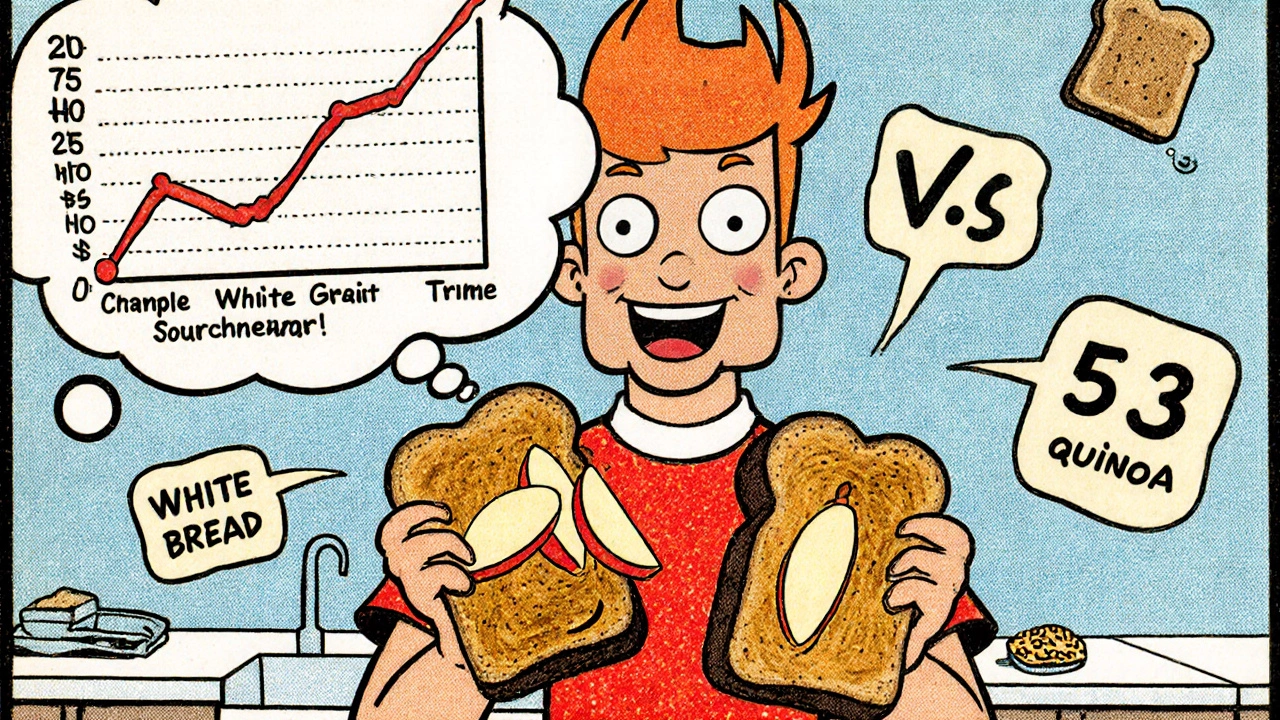Half of all adults with prediabetes don’t even know they have it. That’s not just a statistic-it’s a ticking clock. But here’s the good news: you don’t need pills or surgery to turn things around. What you eat every day can be the most powerful tool you have. And it’s not about cutting out everything you love. It’s about making smarter swaps that keep your blood sugar steady, your energy up, and your risk of type 2 diabetes way down.
Why Fiber Is Your Secret Weapon
Fiber doesn’t just help you feel full. It slows down how fast sugar enters your bloodstream. That means no spikes, no crashes, and less stress on your pancreas. The goal? Get 25 to 38 grams a day. That’s not as hard as it sounds. Start with your plate. Fill at least half of it with non-starchy vegetables-broccoli, spinach, zucchini, bell peppers. One cup of broccoli gives you about 5 grams of fiber. A cup of lentils? Nearly 16 grams. That’s more than half your daily target in one bowl. Whole grains matter too. Swap white bread for sourdough rye, white rice for barley or quinoa. The American Diabetes Association says at least half your grain intake should be whole. Why? A 2021 study found every extra 10 grams of fiber a day cut diabetes risk by 23%. That’s like getting a free health insurance discount just by eating more beans and oats. Don’t forget snacks. An apple with the skin on? 4 grams. A handful of almonds? 3.5 grams. A cup of berries? 8 grams. These aren’t just healthy-they’re blood-sugar friendly. And they keep you from reaching for cookies or chips when hunger hits.Protein Isn’t Just for Muscles
Protein doesn’t raise blood sugar like carbs do. In fact, it helps tame the spike. When you eat carbs with protein, your body absorbs the sugar slower. That’s why pairing fruit with nuts or yogurt works so well. Try this: instead of grabbing a banana alone, have it with 2 tablespoons of natural peanut butter. Or swap your morning toast for scrambled eggs with sautéed spinach. One study showed people who ate protein-rich breakfasts had 30% lower blood sugar spikes by lunchtime. Choose lean sources: fish, chicken, turkey, eggs, tofu, tempeh, lentils, chickpeas. The International Diabetes Federation recommends protein make up 15-20% of your daily calories. That’s about 1 gram of protein per kilogram of body weight. For a 70kg person, that’s 70 grams a day-easily done with three meals and a snack. Avoid too much red meat. A 2020 analysis found eating 100 grams of red meat a day-about the size of a deck of cards-raised diabetes risk by 20%. Processed meats like bacon and sausages? Even worse. Swap them out. Try grilled salmon instead of steak. Or a black bean burger instead of a beef one.Glycemic Index: What It Really Means for You
The glycemic index (GI) tells you how fast a food turns into sugar in your blood. High GI = fast spike. Low GI = slow, steady rise. Here’s what to avoid:- White bread (GI 75)
- White rice (GI 73)
- Potatoes (GI 85)
- Sugary cereals (GI 80+)
- Most fruit juices
- Quinoa (GI 53)
- Sweet potatoes (GI 44)
- Steel-cut oats (GI 55)
- Barley (GI 28)
- Berries, apples, pears (GI 30-40)

The Mediterranean Diet: Simple, Proven, Sustainable
You don’t need a complicated plan. The Mediterranean diet keeps coming up for a reason: it works. It’s not a diet. It’s a way of eating. Think:- Veggies at every meal
- Whole grains instead of refined
- Legumes (beans, lentils, chickpeas) 3-4 times a week
- Fish twice a week
- Olive oil as your main fat
- Nuts and seeds as snacks
- Small amounts of dairy-mostly yogurt and cheese
- Little to no sugar or processed food
What Doesn’t Work (And Why)
Some people try extreme low-carb diets. They lose weight fast. But long-term? Many bounce back. And cutting out entire food groups can leave you missing out on fiber, vitamins, and gut-friendly bacteria. Others think they need to eliminate fruit. That’s a myth. Berries, apples, pears, kiwi-all low-GI, high-fiber, and packed with antioxidants. The problem isn’t fruit. It’s juice. And fruit snacks. And eating three apples at once. Portion control is the missing piece for most people. A 2022 survey found 68% of prediabetic adults struggled with portion sizes, especially with carbs. The fix? Use your plate as a guide:- Half plate: non-starchy veggies
- Quarter plate: lean protein
- Quarter plate: whole grains or starchy veggies

Real People, Real Results
One person on a diabetes forum switched from instant oatmeal to steel-cut oats. Their morning blood sugar dropped by 30 points-every day. Another swapped white rice for quinoa and added lentils to their lunch. Within three months, their HbA1c dropped from 6.1% to 5.4%-back in the normal range. These aren’t miracles. They’re choices. Small, repeated, consistent choices.Start Small. Stay Consistent.
You don’t have to overhaul your life tomorrow. Pick one thing:- Swap white bread for whole grain at breakfast.
- Add a cup of broccoli to your dinner.
- Pair your afternoon fruit with a handful of almonds.
- Drink water instead of soda.
Can I still eat fruit if I’m prediabetic?
Yes-especially berries, apples, pears, and kiwi. These are low in sugar and high in fiber. The key is portion size: stick to one cup per serving. Avoid fruit juice and dried fruit, which spike blood sugar fast. Pair fruit with protein or healthy fat, like nuts or Greek yogurt, to slow sugar absorption.
How much fiber do I really need each day?
Aim for 25 to 38 grams daily, depending on your age and gender. Women under 50 should target 25 grams, men 38. Most people only get about half that. Boost your intake by eating more beans, lentils, vegetables, whole grains, nuts, and seeds. A cup of cooked lentils gives you nearly 16 grams-that’s more than half your daily goal in one meal.
Is the glycemic index the only thing I should worry about?
No. GI is helpful, but it’s not the whole picture. Portion size, food combinations, and cooking methods matter too. For example, mashed potatoes have a higher GI than baked ones. And eating pasta al dente lowers its GI compared to overcooked. Pairing carbs with protein or fat also lowers the overall blood sugar impact. Use GI as a guide, not a rulebook.
Can I eat carbs and still reverse prediabetes?
Absolutely. The problem isn’t carbs-it’s the type and amount. Refined carbs like white bread, pastries, and sugary drinks are the issue. Whole grains, legumes, and starchy vegetables like sweet potatoes are fine in controlled portions. Focus on quality, not elimination. A plate with half veggies, a quarter lean protein, and a quarter whole grains is a winning formula.
How long does it take to see results from a prediabetes diet?
Some people notice less fatigue and fewer sugar crashes within days. Blood sugar readings often improve in 2-4 weeks. HbA1c levels, which reflect average blood sugar over 3 months, typically drop by 0.5% or more in 6 months with consistent changes. Weight loss of just 5-7% of your body weight can cut diabetes risk by over half. Progress isn’t always fast-but it’s powerful.


Brad Seymour
I tried this low-GI stuff for a month and honestly? My energy didn't crash after lunch anymore. No more 3 p.m. nap attempts. Just... steady. Weird how simple swaps work when you stop overcomplicating it. 🙌